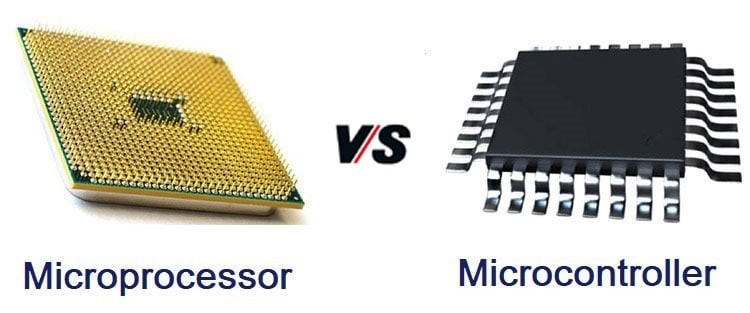
Microcontrollers and microprocessors are two terms that are often used interchangeably in the world of electronics and now in the IoT and Embedded world. However, they are not the same, and understanding the differences between the two is crucial for any engineer or hobbyist looking to work with these components. In this blog, we will explore the key differences between microcontrollers and microprocessors, their features, and their applications.
What are Microcontrollers?
A microcontroller is a small computer on a single integrated circuit chip that includes a processor core, memory, and input/output peripherals. Microcontrollers are designed to perform specific tasks, and they are commonly used in embedded systems. Embedded systems are systems that perform a specific task and are integrated into a larger device.
Features of Microcontrollers
Low power consumption: Microcontrollers are designed to operate on low power and are therefore suitable for battery-powered applications.
On-chip peripherals: Microcontrollers have a wide range of on-chip peripherals, such as timers, analog-to-digital converters, and communication interfaces.
Real-time processing: Microcontrollers are designed to perform real-time processing, which makes them ideal for applications that require quick response times.
Small size: Microcontrollers are small in size, which makes them suitable for use in small devices.
Applications of Microcontrollers
Automotive: Microcontrollers are used extensively in automotive applications, such as engine control units, transmission control units, and airbag control units.
Consumer electronics: Microcontrollers are used in consumer electronics such as smartphones, smartwatches, and remote controls.
Medical devices: Microcontrollers are used in medical devices, such as pacemakers, glucose meters, and insulin pumps.
Example of Microcontrollers
There are wide range of microcontrollers available for eg.
Nuvoton microcontrollers such as MS51FB9AE, MS51FB9AE, MS51FB9AE, MS51FB9AE, Nuvoton M032SE3AE, and more.
Espressif microcontrollers like ESP32, ESP8266, etc
Arduino UNO, Arduino Mega, Arduino Nano, etc.
Check best in class microcontrollers available at campuscomponent
What are Microprocessors?
A microprocessor is the central processing unit (CPU) of a computer. It is a general-purpose device that performs arithmetic and logic operations, controls the timing of operations, and communicates with other devices. Microprocessors do not have on-chip memory or input/output peripherals and require additional components to function.
Features of Microprocessors
High processing power: Microprocessors have high processing power and are suitable for applications that require complex computations.
No on-chip peripherals: Microprocessors do not have on-chip peripherals and require additional components to function.
Large memory: Microprocessors have large memory, which makes them suitable for applications that require large amounts of data storage.
Modular design: Microprocessors have a modular design and can be used in a variety of different applications.
Applications of Microprocessors
Personal computers: Microprocessors are used in personal computers, where they perform all the calculations and control the overall function of the system.
Gaming consoles: Microprocessors are used in gaming consoles, such as the PlayStation and Xbox, where they process the graphics and game logic.
Industrial control systems: Microprocessors are used in industrial control systems, such as Programmable Logic Controllers (PLCs), where they perform control functions in factories and other industrial settings.
Example of Microprocessors
Raspberry-Pi : Raspberry Pi 3 Model B, Raspberry Pi Camera Module, and many more using Raspberry-pi processor.
ARM
Atmel, etc.
Check best in class microprocessors available at campuscomponent
Difference Between Microcontroller and Microprocessor
| Parameter | Microcontroller | Microprocessor |
|---|---|---|
| Definition | An integrated circuit designed to perform specific tasks, typically within embedded systems. | A central processing unit (CPU) used in computers to perform general-purpose processing tasks. |
| Power Consumption | Low power consumption, suitable for battery-powered devices. | Higher power consumption, suitable for desktops and high-performance applications. |
| On-Chip Peripherals | Includes built-in peripherals like ADC, DAC, timers, I/O ports, etc. | Typically lacks on-chip peripherals, relying on external components for additional functions. |
| Memory | Limited memory integrated on-chip (RAM, ROM, EEPROM). | Requires external memory modules (RAM, ROM). |
| Real-Time Processing | Designed for real-time processing and control applications. | Not optimized for real-time processing, used in applications where performance is critical. |
| Size | Smaller in size, integrates more functionalities on a single chip. | Larger in size due to the need for external components. |
| Register | Limited number of general-purpose registers. | Larger number of registers, facilitating complex computations. |
| Applications | Embedded systems, IoT devices, automotive, appliances. | Personal computers, servers, laptops, high-performance systems. |
| Process | Focus on control-oriented tasks and specific applications. | Focus on computational tasks and general-purpose processing. |
| Cost | Lower cost, making them economical for mass-produced products. | Higher cost due to increased complexity and additional components. |
| Examples | Arduino (ATmega328), PIC, ARM Cortex-M series. | Intel Core i7, AMD Ryzen, ARM Cortex-A series. |
| Operating Speed | Generally operates at lower speeds (MHz range). | Operates at higher speeds (GHz range). |
| Interrupt Handling | Efficient interrupt handling for real-time applications. | Less efficient interrupt handling compared to microcontrollers. |
| Ease of Use | Easier to program for specific tasks with integrated development environments (IDEs). | Requires more complex setup and software for development. |
| Flexibility | Limited flexibility, designed for specific applications. | Highly flexible, suitable for a wide range of applications. |
Conclusion
In conclusion, microcontrollers and microprocessors are both important components in the world of electronics. Microcontrollers are designed for specific tasks and have on-chip peripherals, while microprocessors are general-purpose devices that require additional components to function. Understanding the differences between the two can help engineers and hobbyists choose the right component for their specific application.

